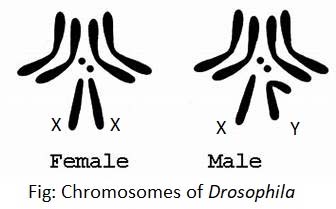Most animals and many plants show sexual dimorphism; in other words, individuals are either male or female. In most of these cases, sex is determined by a special pair of sex chromosomes.
Discovery
T. H. Morgan was an American geneticist. He observed the chromosomes of Drosophilla under microscope, he found a difference between the chromosomes of male and female flies. He found that female flies have four pairs of homologous chromosomes, while male flies have three pairs of homologous chromosomes similar to female flies and one pair of chromosome in which two members are different from one another. One member of this pair of different chromosomes was similar to the chromosomes of the forth pair of female flies, while other member was different. This pair of morphologically different chromosomes is called heteromorphic pair. T. H. Morgan considered this difference as the basis of difference of sex. In the female flies, both members of forth pair were rod-shaped and were called X-chromosomes. In male flies, one member of this pair is rod-shaped (X-chromosomes), but other one is J-shaped and was called Y-chromosome.

The X and Y chromosomes determine the sex of the individuals and therefore are called sex chromosomes (or allosomes). The chromosomes other than sex chromosomes are called autosomes.
Sex Chromosomes in Human
In most of these cases, sex is determined by a special pair of sex chromosomes. Let’s look at humans as an example. Human body cells have 46 chromosomes: 22 homologous pairs of autosomes plus 2 sex chromosomes.
In females, there is a pair of identical sex chromosomes called the X chromosomes.
In males, there is a nonidentical pair, consisting of one X and one Y. The Y chromosome is considerably shorter than the X.
At meiosis in females, the two X chromosomes pair and segregate like autosomes so that each egg receives one X chromosome.
Hence with regard to sex chromosomes the gametes are of only one type, and the female is said to be the homogametic sex.
At meiosis in males, the X and the Y chromosomes pair over a short region, which ensures that the X and Y separate to opposite ends of the meiotic cell,creating two types of sperm,half with an X and the other half with a Y. Therefore the male is called the heterogametic sex.
